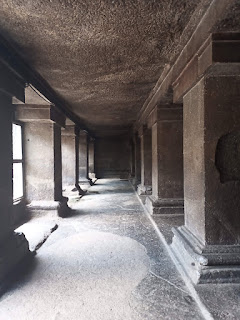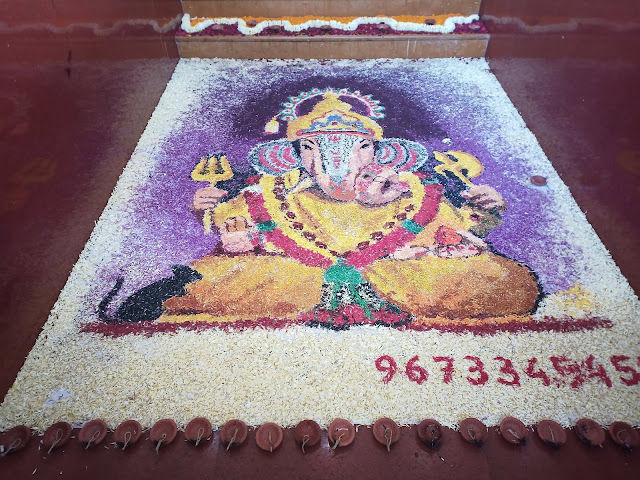An Archaeologist's Guide to Maharashtra, India: Pune
Leaving Gujarat, my next stop was in the western state of Maharashtra. Aside from Pav Bhaji, a delicious Maharastran snack where buttered and fried bread rolls are served with a vegetable curry, this state is known for its official language of Marathi.

Brushing up on the history of the state, I learned that Maharashtra was established as a separate Marathi-speaking state in 1960 following prolonged mass protests and the deaths of over 100 people who were demonstrating against the existence of the bilingual Bombay state that had been formed during independence in 1947. This historical entity was divided into two separate states, Maharashtra for the Marathi-speaking population, and Gujarat for the Gujarati speakers.
I began my archaeological exploration of Maharashtra in Pune, the second biggest city in the state.
Being a temple, the site is free to enter and accessible daily. On approach from the main road, a lush tree-lined path leads you to an area between two large rock walls and into the main temple area. Here you are met with a round temple structure containing carved statues.
My visit to Pune was during Diwali, the five-day Hindu festival of the lights. At the temple complex young people sporting their Diwali finest were posing between the rock pillars for copious photos taken by friends and family.
Beyond the circular rock structure is the main temple, which has been cut from one piece of rock. Visitors must remove their shoes outside the steps leading into the temple. Once inside, I felt the temperature drop considerably due to the subterranean cave, which provided welcome relief from the heat and humidity outside.
The temple has a pillared forecourt, with small chambers branching off from here in which Diwali worshippers left offerings of flowers and perfumed oils. Designs were cut into the rock, including etched sketches and outlines of gods.




One element of note, which I unfortunately was not aware of during my visit, is that the site museum houses a grain of rice which has been inscribed with 5000 characters and has been featured in the Guiness Book of World Records.

Brushing up on the history of the state, I learned that Maharashtra was established as a separate Marathi-speaking state in 1960 following prolonged mass protests and the deaths of over 100 people who were demonstrating against the existence of the bilingual Bombay state that had been formed during independence in 1947. This historical entity was divided into two separate states, Maharashtra for the Marathi-speaking population, and Gujarat for the Gujarati speakers.
I began my archaeological exploration of Maharashtra in Pune, the second biggest city in the state.
Pataleshwar Cave Temple
My first stop was the Pataleshwar Cave Temple complex, a temple carved out of rock during the 8th century CE during the Rashtrakuta dynasty, whose kings were known to espouse religious tolerance to the popular religions of Hinduism, Jainism and Buddhism during their reigns. The temple is dedicated to the Hindu god Shiva.Being a temple, the site is free to enter and accessible daily. On approach from the main road, a lush tree-lined path leads you to an area between two large rock walls and into the main temple area. Here you are met with a round temple structure containing carved statues.
My visit to Pune was during Diwali, the five-day Hindu festival of the lights. At the temple complex young people sporting their Diwali finest were posing between the rock pillars for copious photos taken by friends and family.
Beyond the circular rock structure is the main temple, which has been cut from one piece of rock. Visitors must remove their shoes outside the steps leading into the temple. Once inside, I felt the temperature drop considerably due to the subterranean cave, which provided welcome relief from the heat and humidity outside.
The temple has a pillared forecourt, with small chambers branching off from here in which Diwali worshippers left offerings of flowers and perfumed oils. Designs were cut into the rock, including etched sketches and outlines of gods.




One element of note, which I unfortunately was not aware of during my visit, is that the site museum houses a grain of rice which has been inscribed with 5000 characters and has been featured in the Guiness Book of World Records.
Shaniwar Wada
Further south, in the main city centre of Pune, is the 18th century CE Shaniwar Wada fortification. This complex was home to the Peshwas, who were the Prime Ministers of the Maratha Empire, a Marathi-speaking warrior group who established Swarajya (self-rule of Hindu people).
The fort was heavily damaged in a fire in the early 19th century, but what remains of it has been preserved and turned into a tourist attraction. After entering the large doors at the imposing entry to the fort, foreign visitors are charged 125 rupees (about 1.70 USD or 2.50 AUD). The fort is open daily.
Inside are the architectural remnants of the fort's interior, with stone-lined grids marking the bases of buildings that are no longer present, and lush grass covering the site. Small plaques provide information about each of the rooms and areas that once stood here.
Visitors also have the opportunity to climb a few sets of steep stairs to the top of the fortification wall, which then allows you to walk along the entirety of the wall and take in interesting views both into and out of the fort complex.
Aga Khan Palace
The Aga Khan Palace is a short distance out of the main city centre of Pune. The palace is located in a large leafy area of land and was built by the Sultan Muhammed Shah Aga Khan III, who worked to advance rights of Muslims in India. However, the main reason this palace is significant to Indian history is that it was used as a prison in 1942-1944 for Mahatma Gandhi, his wife Kasturba, his secretary Mahadev Desai, and Sarojini Naidu who was a prominent poet and anti-imperialist spokeswoman for the end of colonial rule.
Gandhi, his wife and secretary were held in this make-shift prison following the launch of the Quit India Movement in 1942, which was initiated by Gandhi to demand an end to the British occupation of India, and was followed by a mass protest. It is during their captivity here that Kasturba died. In 1969 the palace was donated to the people of India to mark its significance to recent Indian history.
Visitors to the palace today are charged 250 rupees (about 3.50 USD or 5 AUD) for entry, and are granted access to the palace and its grounds, including the location where Gandhi's ashes are kept. Rather than the opulent palatial furnishings that I have seen when visiting other palaces around India, this palace has been converted into a museum commemorating Gandhi and Kasturba for their great contribution in freeing India from imperial rule. Each room that branches off from the large balcony winding around the building contains information about the freedom movement in India and personal items used by Gandhi and his peers during their time here. The museum extends over the ground and first floor, but during my visit the first floor was closed due to renovation.
Other Historical Structures
Back in the main city centre, I wound my way through the side streets to visit a few points of note that I had found on the map. These included the Lal Mahal, which is a modern reconstruction of the Red Palace that was said to be home to the warrior king Shivaji; the original fell into disrepair and was replaced by this reconstruction. Although I did not enter this building as part of my travels, visitors can find out more about Shivaji by visiting the Lal Mahal site.
Another building of note is the Sardar Shitole Wada, which was the historical home of a prominent family in the area, and includes a small shrine on its grounds. Clearly this building has seen better days, with advertisements for martial arts and ladies fitness training covering part of the exterior facade.
Temples
Kasba Ganpati
Diwali was a wonderful time to be in Pune. The city was incredibly vibrant and colourful, and worshippers trailed in and out of various temples and shrines to give their offerings and prayers. Pune has been known as the city of Ganesh (for whom Ganpati is another name), the Hindu elephant-headed god of intellect and wisdom, since the year 1630 when a number of prominent Maratha families migrated to this area and brought their family deity with them. The Kasba Ganpati temple was built by these families in the location in which it is still found today.
As you can see, the facade of the temple was decorated with strings of beads and lanterns, and colourful powder and flowers were used to create intricate patterns and writing on the floor.
Shreemant Dagdusheth Halwai Ganpati Mandir (Ganesh Temple)
The other temple that I visited was even busier than the first. I waited in a long, winding line of people to enter the temple, and stayed for only a short time as there were hundreds of worshippers pouring in to offer their prayers and devotions. This temple houses a beautiful gold statue of the god Ganesh, and worshippers offer flowers and fruits in front of the shrine. The temple is the most visited in Pune, and is the inspiration for the Ganpati festival that takes place in the city every year.
This temple was absolutely amazing and is a must see for anyone travelling through Pune.
Deccan College Archaeology Museum
One place that I intended to visit but did not get the chance (due to closure for the Diwali public holiday) is the archaeology museum at Deccan College, which began in 1821 as a Hindu college and has expanded to become one of the most notable post-graduate education institutions in India. The archaeology department was founded in 1939 and is one of great repute, with students travelling from across India and South Asia to study archaeology here. The museum's collections include galleries on prehistory and protohistory, art and architecture, epigraphy and numismatics (study of coins) and historical and ethnoarchaeological galleries.
The museum's website announces that a new archaeological museum is under construction.
In Summary
My time in Pune was one of my favourite parts of my India trip despite the main reason for my visit, the Deccan College archaeological museum, being closed. In addition to the impressive history and archaeology of the city, experiencing Diwali in this cultural hub was an amazing experience, and I would gladly return to Pune (perhaps when the new museum is completed!).















One small correction in your otherwise impressive blog on one of my most favourite cities - Only Kasturba Gandhi died in prison in the Aga Khan palace. Mahatma Gandhi died much later in 1948 when he was assassinated in Delhi. So his ashes must have been brought and preserved in the palace in Pune.
ReplyDeleteThanks for your comment! I have updated the article :)
DeleteExtremely well written account of Pune and its archeological wonders - took me back to the time I spent there as an Engineering student residing very close to the Pataleshwar Temple complex. Maybe for your next trips you can visit some of the cliffs and forts that surround Pune e.g. Sinhgad, Rajgad,etc. that will surely pique your interest further.
ReplyDelete